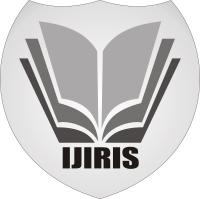SUSTAINABILITY APPROACH IN GREENING BUILDINGS BY AN ADVANCED UNBIASED SCIENTIFIC TOOL
IJIRIS:: International Journal of Innovative Research in Information Security, Volume VI (Issue I):
12-19 (January 2019)1. Timmons, D., Harris, J. M., Roach, B. (2014), The Economics of Renewable Energy, A GDAE Teaching Module on Social and Environmental Issues in Economics. Online. Available: http://www.ase.tufts.edu/gdae/education_materials/modules/RenewableEnergyEcon.pdf accessed February, 2018. 2. Rawat, D., Sauni, P. (2015, July-August), Importance and Prospects of Renewable Energy: Emerging Issues in India, International Journal of Art & Humanity Science (IJAHS), e-ISSN: 2349-5235, Volume 2, Issue 4, pp. 11-18. 3. Bhatt, R., Macwan, J.E.M., Bhatt, D., Patel, V. (2010), Analytic Hierarchy Process Approach for Criteria Ranking of Sustainable Building Assessment: A Case Study, World Applied Sciences Journal 8 (7), pp. 881-888, ISSN 1818-4952, Retrieved from https://pdfs.semanticscholar.org/bdee/4a4c30d0dd1aed3245021704d2871b50b516.pdf accessed Jan 10, 2018. 4. Raha, P., Sarkar, D. (2013), Energy Audit Report of Nabo Jibon - Howrah, conducted by Energy Management Department, Master of Public System Management, Indian Institute of Social Welfare & Business Management, Kolkata. 5. Thakurta, A. G., Ghosh, D., Umashankar, S. (2004), Project Report on Energy Audit of IISWBM Building, conducted by Energy Management Department, Master of Public System Management, IISWBM, Kolkata. 6. IISWBM (2015), Study of Energy Use and the Working of Solar P. V. Net Metering System at RKM Vivekananda Centenary College - Rahara, conducted by Energy Management Department, Master of Public System Management, Indian Institute of Social Welfare & Business Management, Kolkata. 7. Gupta, N. (2015), Sustainable Energy Studies at Sri Mayapur Dham, conducted by Energy Management Department, Master of Public System Management, Indian Institute of Social Welfare & Business Management, Kolkata. 8. Dutta, P. (2015), Assessment of the Potential of Biomass based Cogeneration at Sri Mayapurdham, conducted by Energy Management Department, Indian Institute of Social Welfare & Business Management, Kolkata. 9. Majumdar, S.B., Choudhury, B.K. (2017), Greening Buildings: Action based on Identification of Retrofitted Parameters, IJIRAE, Vol. 4, Issue 8, ISSN (Online): 2349-2163. 10. Majumdar, S.B., Choudhury, B.K. (2017), Application of Scientific Decision Supporting Tool to Optimize Energy Consumption in way of Greening the Existing Buildings, IJIRSET, Vol. 6, Issue 8, ISSN (Online): 2319-8753..DOI: doi://10.26562/IJIRIS.2019.JAIS10081
Abstract
Energy is now an indispensible resource for any activities in our day to day life. Optimum use of energy is more and more discovered today to be the secret of technological, economic and social supremacy of any nation in general and sustainability of human civilization to be more specific. Appropriate Energy Policy for the international and national bodies is at an evolving stage as research has revealed that sustainability of any organization is directly related to optimum use of energy which is reflected in Sustainability Index. Such policies on implementation through planning and analysis of energy intensive processes and gadgets, often stalled at a point of ambiguity because of lack of scientific parameters to help in the decision making process. For example, in energy studies and energy audit, the recommendations seems to be better with respect to other on certain parameters, such as, energy saving, CO2 emission reduction, monetary saving, pay-back-period, return-on-investment, internal-rate-of-return, etc. However, different parameters often suggests different order of preference for such recommendations leading to conflicts and stalling the implementation process and thus retarding the sustainability march of the body in particular and nation as well as globe in general. The present paper also finds a scientific solution to turn the conflict into a binding force by incorporating each opinion in a Multi-Criteria Decision Making Process leading to obvious ranking of alternatives through application of tools, such as AHP and ELECTRE. The various cases also presented in the paper confirm the validity of the process in University Campus, Greening of Buildings and Industry.
Description
Each stage of economic development in India has been accompanied by a characteristic energy transition from one major fuel source to another. Till today, fossil fuels like coal, oil and natural gas, are by far the dominant energy source in industrial economies, and the main source of energy production growth in developing economies. But today’s and future century is already bearing in mind the start of the next great transition in energy sources - away from fossil fuels towards renewable energy sources. This transition is motivated by many factors, including apprehensions about environmental impacts (particularly climate change), limits on fossil fuel supplies, prices, and technological changes [1]. Moreover, a number of studies are continuously being carried out by various organizations like Indian Renewable Energy Development Agency (IREDA), Ministry of New and Renewable Energy (MNRE), The Energy and Resources Institute (TERI), National Environmental Engineering Research Institute (NEERI) etc., with the aim of further development in the field of alternative resources of energy - thus to accomplish ‘greening buildings’ projects more fruitfully [2].
Industrial Sustainability Index (ISI) in terms of the sustainable development philosophy helps to identify the issues that have to be addressed in order to get the industry closer to a sustainable performance. For this purpose multi criteria decision making theory was chosen as the methodology that provided the methodology to analyze in a decision tree. The main three branches were divided into economic, social, and environmental attributes. Through this index, it is possible to evaluate the economic-financial situation of an industry, as well as the well being of its workers, and its surroundings considering the environmental, economic and social systems. Hopefully the MCDM solving tools, discussed in our study will play a vital role in this transitional zone to solve these types of prioritization problems diplomatically and also to help the decision makers to select the right alternative of power generation by viewing the rankings generated at the output of the tool/algorithm used. It can be predicted also that these types of attractive MCDM tools/ algorithms will help the decision makers by resolving conflicts generated, for coming 100 years also in the area of power generation.
